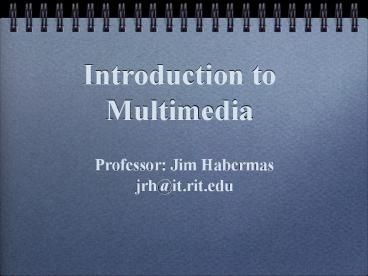Introduction to Multimedia - PowerPoint PPT Presentation
1 / 9
Title:
Introduction to Multimedia
Description:
'Tim Berners-Lee is the Director of the World Wide Web Consortium, a Senior ... http://learn.elementk.com/ResourceCenter/ReferenceBooks/toc.asp?bookid=499 3 ... – PowerPoint PPT presentation
Number of Views:26
Avg rating:3.0/5.0
Title: Introduction to Multimedia
1
Introduction to Multimedia
- Professor Jim Habermas
- jrh_at_it.rit.edu
2
Definition of Multimedia
- From etymology Multi numerous media
medium intermediary - In information field Multimedia means multiple
means by which information is stored,
transmitted, presented and perceived.
3
CD-Roms / DVDs / WWW
- In the past, the word "multimedia" made many
users think of CD-ROMs and later DVDs, not Web
sites. But now true multimedia has come to the
Web with the increased online use of the rich
media and interactivity once reserved for CDs. - The Web is just one way to present multimedia
along with CDs, DVDs, and other platforms. - Programs such as Director and Flash have
tremendously enhanced the ability to use the WWW
for multimedia presentations
http//www.7up.com
http//www.coke.com/flashIndex1.html
4
Digital multimedia
- Digital multimedia is the field concerned with
the computer-controlled integration of text,
graphics, still and moving images, animation,
sounds, and any other medium where every type of
information can be represented, stored,
transmitted, and processed digitally.
5
Challenges of multimedia system design
- Host computing power requirement
- Data storage and management requirements.
- Cross platforms - different hardware and
operating systems. - Human interface - Interactivity - the user can
control the presentation of information being
presented.
6
Hypermedia
- Application of hypertext concept to multimedia
documents - Linking or embedding of multimedia objects
- System components (e.g. Word-Wide Web)
- makeup language e.g. HyperText Markup Language
(HTML) - directory service e.g. Uniform Resource Locator
(URL) - communication protocols HyperText Transfer
Protocol (HTTP), File Transfer Protocol (FTP)
7
OS Hardware support for multimedia
- The viewer's equipment has to be powerful enough
to support the multimedia presentation. - Real-time services required e.g., to satisfy the
continuous playback requirements of media data
such as digitized audio and video. - Web surfers who still use a modem, the slow
download speed can make the online multimedia
experience sometimes frustrating.
8
Key Figure in the www
- Tim Berners-Lee is the Director of the World
Wide Web Consortium, a Senior Research Scientist
and the 3COM Founders Professor of Engineering in
the School of Engineering, with a joint
appointment in the Department of Electrical
Engineering and Computer Science MIT's CSAIL
where he leads the Decentralized Information
Group (DIG), and Professor of Computer Science at
Southampton ECS.
9
Resources
This presentation was created using Keynote
version 1.1.1 (software created by the Apple
Computer, Inc.)
Work Cited
Berners-Lee, Tim. "Tim Berners-Lee."
www.w3.org/People. 29 Aug. 2008. World Wide Web
Consortium. 2 Sept. 2008 lthttp//www.w3.org/People
/Berners-Lee/gt.
Multimedia course offered by Prof. Xie. Ken
Fritzsche. 1997. 11 August 2004
lthttp//www.cs.nps.navy.mil/people/faculty/xie/c
s3202/course.htmlgt.
Work Consulted List
(sources I have read but did not specifically use)
Garrand, Timothy. Writing for Multimedia and the
Web. Second Edition. Boston Focal
Press, 27 December 2000. 11 August 2004
lthttp//learn.elementk.com/ResourceCenter/Refere
nceBooks/toc.asp?bookid4993gt.
Professional Web Site MLA Style Crib Sheet. Dr.
Abel Scribe PhD. September 2003. 11 August 2004
lt http//www.docstyles.com/mlacrib.htmReference
sgt.































